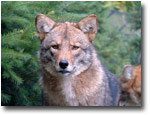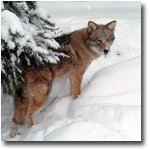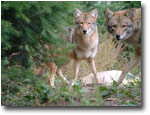Introduction
It was a sunny Sunday afternoon a few years ago when I was driving home from Newburgh, NY on the Taconic State Parkway. Traffic was light, sight distance unlimited and the cruise control was set for 60 MPH as I was making my way back to Long Island. Suddenly, through the corner of my eye, I saw something crossing the road and I instinctively hit the brake pedal. It all happened so fast, but what appeared to be a not-so-small canid had just crossed the road in front of me, just missing a collision with my car. I quickly shifted my focus into the rear-view mirror to see the animal disappearing into the wooded area bordering the highway.
What was it I just saw? As I analyzed the image burned into my memory, my first thought was wolf. It was easily as large as our female German Shepherd, but was certainly not a domesticated dog. But how could it be a wolf when there is no known wolf population in this part of the country?
The following week I placed a call to a New York State biologist and described what I saw. Without hesitation, he told me what I had encountered – the eastern coyote, which is significantly larger than the western coyote that most people are familiar with.
Since then, I have encountered the eastern coyote one other time, in the same manner trotting across the pavement in front of me on a winding New Hampshire back road. Since we have moved into a more rural NH setting, I have also been pleasantly awakened in the middle of the night by the howls of our local population of the eastern coyote, which frequent the pond at the back of our property. What follows is some insight and background on this unique species, provided by wildlife biologist Jon Way.
JE - NPN 0001
Eastern coyotes, a term for the coyotes living in northeastern North America, have been an enigma to scientists and laypeople for many years. This animal started to appear in northern New England and New York in the 1930s and 1940s and currently inhabits all of the northeastern United States and southeastern Canada, ranging from wilderness to urban areas, including some of our larger cities like Boston. The animals are often described as a big version of a coyote or a small wolf, and many northern New Englanders still call them coydogs. Until recently, however, there was only speculation as to what this animal actually is. Now, emerging data, collected by myself and colleagues, have shed new light on this potentially distinct species.
|
I recently reviewed available data on coyote mass (weight) throughout North America and found that the “coyote” living in northeastern North America is indeed the heaviest version of the species. It is clearly heavier than the nearest subspecies of coyote, Canis latrans thamnos, found in the midwestern United States. While size dimorphism was observed between sexes (males being heavier than females), which is consistent with observations of other canids, eastern coyotes were so big that females from that region were 21 percent heavier than male coyotes from outside the Northeast. Furthermore, although Bergmann’s rule, which predicts larger size with increasing latitude (i.e., south to north), has been posited to explain the larger sizes of mammals in colder climates, findings from my study indicate that longitude, or degrees west to east, accounted for greater than four times the amount of variation in coyote mass than did latitude.
Most of the studies in the northeastern United States measured “coyotes” heavier than 40 pounds, which are rare in other parts of the country. I radio-collared a 55-pound female eastern coyote on Cape Cod, Massachusetts, that traveled with more normal-sized (smaller) eastern coyotes. I tracked her for over eight years and documented her giving birth to six litters before she left her territory, becoming nomadic until ultimately getting shot.
There are numerous theories as to why eastern coyotes are bigger. These include: (1) response to enhanced food supply or larger prey; (2) genetic adaptation to prey; and (3) their being coydogs (that is, a coyote-dog mix). Most of the evidence discounts these theories since medium-sized food (mice and rabbits) and deer are abundant throughout the United States, and coydogs reproduce in fall and give birth in winter instead of mating in winter and giving birth in early spring, like the normal wild canid cycle.
The most plausible scenario is that the eastern coyote is actually a hybrid between coyotes and a small type of wolf. Dr. Brad White’s research team at Trent University recently reported that the wolves found in southeastern Canada (around Algonquin Provincial Park) are actually the same species as the red wolf (Canis rufus, or Canis lycaon as proposed) found in the southeastern United States. This “eastern wolf” is smaller, weighing about 60 pounds, and is thought to be more closely related to the coyote than to the gray wolf because coyotes and red/eastern wolves are theorized to have evolved in the New World whereas the gray wolf originated in the Old World. Thus, White’s research group theorized that the genetic similarity of the coyote and Canis lycaon might facilitate hybridization, especially when populations are low in an area. Interestingly, the biggest threat currently facing the red wolf in the southeastern United States is hybridization with coyotes colonizing the periphery of the eastern North Carolina red wolf recovery area.
I have been collaborating with Dr. White’s genetic team, and they recently finished analyzing the genetic results of about 75 of my samples from eastern Massachusetts. Perhaps not surprisingly, they did find evidence for hybridization as they had in New York, Maine, and New Brunswick. The Massachusetts canids contained genetic material from both western coyotes and eastern wolves, which, of course, is consistent with the hypothesis of the hybrid origin of eastern coyotes. They found that our study subjects were mainly eastern coyote, but all also had western coyote and eastern/red wolf genetic influence as well. This means that they are currently breeding true with other eastern coyotes and now have relatively little influence from their parent species. White believes the eastern coyote (Canis latrans x lycaon) should actually be classified as its own species because all of the samples from the Northeast (including from Massachusetts, New York, Maine, and New Brunswick) grouped more closely to each other than to western coyotes or wolves. Interestingly, biologists call these same Canids “Tweed wolves” in Ontario, and White notes that they are a product of hybridization between coyotes and eastern wolves. The genetic distance between groups is consistent with the Massachusetts canids originating in southern Ontario and progressing south, down the eastern US and into Massachusetts.
We are still trying to sort through this “canid soup” and have found variability within study areas with some “coyotes” having nearly pure red/eastern wolf and others having much western coyote DNA. We will likely not be able to officially call the eastern coyote a new species until we sample throughout the Northeast and determine where they become less “eastern coyote” and more “western coyote” or “eastern wolflike.” However, it is obvious that the eastern coyote is indeed distinct when I compare the size and physical makeup of eastern and western coyotes. Because of their distinctiveness, we suggest that the eastern coyote be called the eastern coywolf or just coywolf (C. latrans x lycaon), which better reflects the genetic composition of this highly successful canid.
Ecologically, this “coywolf” behaves as one might predict for a 30-to-40-pound canid. On average, it has a larger home range than most western coyotes (but smaller than wolves, at about 10 square miles), it travels long distances daily (10–15 miles), it eats a variety of food including deer but focuses on medium-sized prey such as rabbits and voles, and it is very social (when not killed by people), often living in families of three to five members (note: western coyotes have also been found to be social where there is abundant prey). In short, it has ecological and physical characteristics that can be seen on a continuum of coyotelike to wolflike.
In addition to the eastern coyote/coywolf, however, there have also been a number of apparently pure wolves that have made it to the northeastern United States in the past 10 to 20 years. These wolves seem to be either eastern, gray, or a hybrid of the two but have limited eastern coyote genes. Current wolf range in southern Canada is within 100 miles of the United States, a distance that wolves (or coywolves) could travel in a week or two. Unfortunately, all of these wolves have been found dead before anyone could monitor them. Why is this the case? Many believe it to be because northeastern states provide little protection to their similar looking cousins, the eastern coyote/coywolf. All states have a liberal hunting season on them, with most allowing unlimited, year-round killing. I have always found it peculiar that eastern coyotes/coywolves, which look so similar to eastern wolves, are afforded virtually no protection while wolves are still on the endangered species list in the Northeast and are currently returning to the area on their own.
As a biologist studying the coywolf, I see an incredibly adaptable and family-oriented animal that is personable, social, sentient and an important member of the ecological community. I have a moral and ethical problem with the fact that most states (42 out of 49) treat them as vermin, especially since only a minority of people hunt, and wildlife watching is now a considerably bigger component of our economy. In fact, wildlife watching (e.g., wildlife photography, bird feeding, nature tourism) generates staggeringly more money for some states (almost 10 to 1 in my home state of Massachusetts), yet there are virtually no designated wildlife watching areas in the northeast (except Baxter State Park) where my wildlife subjects can’t get shot. By wildlife watching areas, I mean ecosystem-size areas that can support multiple members of the largest species or species with the largest territories. For coywolves, this would require a minimum of 100 square miles to support multiple packs of this social species.
The traditional wildlife management standpoint is that if a species is breeding and compensating for its losses, then so what if we kill lots of them? But just because coyotes and coywolves can reproduce quickly does not mean they do not have feelings such as when losing a mate. What if the mate is theirs for four or five years and then it is shot? I think these social, intelligent animals do feel loss. Accordingly, I believe very strongly that all states should have a strict bag limit on coyotes, which is in line with management for most wildlife species. Treating them otherwise sends the wrong message as to the value of these animals both ecologically and aesthetically.
To add further ammunition to my argument is the issue of the wolf in the Northeast. We have a legal obligation to restore a species on the endangered species list to its native range. Many (including myself) now believe that the only way that wolves will likely return to the United States (either by natural recolonization or active reintroduction) is if they and their close kin (i.e., eastern coyotes) are better protected. How many more dead wolves (or large eastern coyotes/coywolves) will it take to force people to pay attention to the fact that wolves are trying to recolonize the northeastern United States?
While state agencies have effectively chosen to do nothing to protect pure wolves returning to the Northeast (as they continue to die at the hands of people), I have also had the amazing opportunity to witness the literal evolution of a species, the eastern coywolf, in the past 50-odd years. I look forward to continuing to study this amazing animal as it continues to evolve and adapt to the different environs of the Northeast!
Comments on NPN wildlife photography articles? Send them to the editor. NPN members may also log in and leave their comments below.
Jon Way is the author of Suburban Howls (see www.easterncoyoteresearch.com), written from a biologist’s perspective but intended for the layperson. The book describes his experiences and findings studying the ecology and behavior of the eastern coyote in urbanized Massachusetts. Please also visit his website to learn how you can support his research efforts (such as getting permits to raise captive eastern coywolves for educational, research, and photographic purposes at his home) and his attempt to establish a wildlife watching area in his home base of Cape Cod, MA.
References:
Jon Way’s Eastern Coyote Research Web site: www.easterncoyoteresearch.com.
Way, J. G. 2007. Suburban Howls: Tracking the Eastern Coyote in Urban Massachusetts. Dog Ear Publishing, Indianapolis, Ind.
Way, J. G. 2007. A comparison of body mass of Canis latrans (Coyotes) between eastern and western North America. Northeastern Naturalist 14(1): 111–24.
Way, J. G., and R. L. Proietto. 2005. Record size female Coyote, Canis latrans. Canadian Field-Naturalist 119(1): 139-40.


